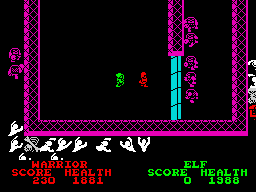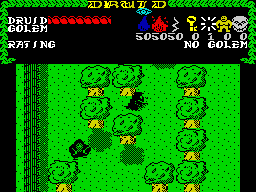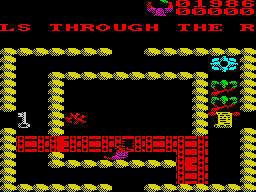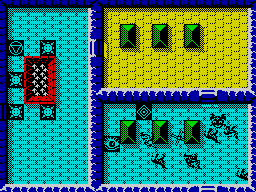
US Gold’s Gauntlet: run it again, and again...
It’s back, after almost three years in the cupboard. CRASH presents, by popular demand, the return of the legendary comparison test.
| Dandy | Ranarama |
| Druid | How to be a Hero |
| Storm | Into the Eagle’s Nest |
| Avenger |
But do great minds really think alike or is it just good old-fashioned plagiarism? RICKY EDDY and ROBIN CANDY discuss the case of the Gauntlet clones.
Why were we suddenly deluged by a flood of Gauntlet-inspired games? The Gauntlet variants have established their own niche, somewhere between arcade adventures and shoot-’em-ups.
Maybe it’s a little unfair to call them all Gauntlet games — it makes them all sound like rip-offs. (Maybe they are.) But with the alternative name being bird’s-eye-view-shoot-’em-ups-in-dungeons, we’ll stick to Gauntlet, with apologies to the ‘unofficial’ versions.
How do you go about Gauntlet-spotting?
Well, a Gauntlet game is seen from overhead and pits the player against a strong opposition. There’s usually some kind of quest, often an obscure one; more often than not, it’s to escape from somewhere. En route you pick up objects such as health potions, power pills, treasure and ammunition to increase your character’s efficiency.
And, if we’re really going by the book, the game should have a two-player option.
So grab your joystick and let’s enter those perfidious dungeons — again.

US Gold’s Gauntlet: run it again, and again...
ROBIN: Gauntlet, the official conversion, arrived in CRASH Towers just in time for the February 1987 issue — where it was immediately Smashed and hailed as ‘a much better game than any of its clones’. It follows the arcade original quite faithfully, with a few limitations due to the limitations of the Spectrum.
The original is a one-to-four-player game where each player plays simultaneously. The abilities of the characters vary — for instance, some are better at combat than others. The aim is to rush about the spacious mazes hacking at anything that moves and eating anything that doesn’t. You have to find a key to get into some parts of the maze.
There are six groups of nasties out to stop you. At the top of the tree comes Death himself, who can only be killed if you have a magic potion; the other baddies can be killed in hand-to-hand combat, or shot.
You have only one life, which is represented by a health score. This goes down when you’re wounded by the enemy and goes up when food and drink are collected. Scattered about each maze are objects which give limited help, such as increased fire power and invisibility.
To progress to the next level you have to find an exit — and if you’re particularly proficient, you can buy The Deeper Dungeons, a 512-screen add-on to Gauntlet.
The biggest letdown in the Spectrum conversion of Gauntlet is the graphics, which are small and simple. And, unlike the arcade original, the Spectrum Gauntlet allows only two players. Still, the conversion retains all the playability and addictive qualities that made the original such a smash hit. The multiload system gets a bit annoying at times — but it’s a small price to pay.
RICKY: Because Gauntlet is the official conversion, it includes all the best features, and it’s no disappointment after the arcade game. However, I could only enjoy Gauntlet as a two-player game — on my own I found it didn’t generate the same enthusiasm.

The first of the flood: Firebird’s Druid
RICKY: Druid was the first successful go at a Gauntlet game, earning itself a CRASH Smash in the Christmas Special last year. The game centres on a druid with the pretty horrendous task of killing off the Princess of Darkness and her evil minions.
The programmers, Andy Bailey and Dean Carter, included three different forms of weapons that the druid can access: water, fire and electricity. Scattered around the playing area are chests containing magic spells which boost the druid’s powers.
There are eight levels of frantic action, and a neat little twist in two-player mode: one player takes control of the Golem, an apelike beast who simply kills off the druid’s foes.
The graphical representation of the many characters is good, mainly in black; however, the colourful backdrops add spice to the scenery. The informative status panel gives Druid an advantage over the other Gauntlet games.
Of all the Gauntlet clones, this one certainly stands out as both a good adaptation of the theme and an enjoyable game in its own right.
ROBIN: This was one of the first Gauntlet-type clones available, and it was highly rated in CRASH. The main difference between Druid and Gauntlet is the spell-casting (later reproduced in Ranarama), a novel feature. Graphically it’s excellent, but the sound is a little disappointing. Hugely playable and addictive, it’s certainly one of the better clones around.

Kwon with the wind in Gremlin Graphic’s Avenger
RICKY: Loosely labelled Way of the Tiger II, Avenger romped in for the Christmas Gauntlet craze. It follows the standard routine for Gauntlet clones, but with an Oriental flavour. You play a ninja warrior out to avenge the death of his father (known locally as Grasshopper, because of the way he clicked his knees together).
Anyway... scroll on. And that’s exactly what you’re out to find — the scrolls that will save Kwon (who just happens to be rather an important god) from being lost in eternal hell. Why this ninja should want to help him is beyond us, but that’s what you’ve got to do.
The action is set in and around the Quench Heart Castle, where three Guardians must be annihilated to locate the scrolls. The guardians have their own minions, ranging from he-uge spiders to horned demons — all quite intelligent and all out to kill you.
You are equipped with ten star-shaped blades to lob at these foes. But when these are used up your ninja faces hand-to-hand combat, unless he can find more. (Other traditional Gauntlet goodies can be collected, too).
Energy and life force must be watched closely; without these you suddenly become an ex-ninja (this ninja is no more... (cut the parrot sketch jokes — ED)). But if you’re in difficulty you can call on Kwon for a quick top-up.
Though the maze is mainly in monochrome, the scenery has plenty of colour to liven up the display, This and the detailed and smoothly-animated characters add up to a highly attractive game. And the gameplay doesn’t suffer from this indulgence in graphics — it succeeds as what it’s designed to be: a fast, exciting but challenging quest.
To top it off, the sound FX and title tune are neat, making Avenger a pleasant addition to the range.
ROBIN: As a sequel to an enjoyable game, this was a disappointment. Most of the action is presented in black-and-white, though the animation more than makes up for that. Gameplay is enjoyable and can be addictive for a while.
But it still boils down to another Gauntlet game with few innovations. And probably the biggest disappointment is the lack of a two-player option, which after all is the highlight of any Gauntlet game.

‘Turn to the desired direction and move’: the wisdom of Confucius ONLY FROM Mastertronic in Storm
ROBIN: Una Cum the wicked one has made off with fearless Storm’s wife, the delectable Corrine. She’s been locked up in Una’s laboratory while he’s off looking for a box called The Fear.
As soon as Storm heard of this, he set off to retrieve his sweetheart from the castle, stopping en route to enlist the help of Agravian The Undead (who only appears in two-player mode). To free Corrine they must collect three snake brooches.
Storm was one of the first Gauntlet clones, and it has many Gauntletesque features, such as keys to open locked doors and food to replenish energy.
The one distinguishing feature of Storm is the control method. Storm rotates either clockwise or anticlockwise, and another key is used to propel him forward. This method suits some of the 3-D isometric games, but I found it fiddly.
Graphically Storm is very boring: the graphics are big, but designed with little attention to detail. I found it immensely boring and not a patch on most of the other Gauntlet games. Even at its budget price, steer clear of this one.
RICKY: Storm was originally an Amstrad game — and it shows. The graphics are absurdly blocky, so movement is jerky. The control method is strange, because Storm could have been such a fast-moving storm; ‘Turn to the desired direction and move’ just adds to the frustration, making it almost impossible to enjoy the game. Avoid.

Hey, this is no way to Ranarama! WhaddyathinkIam, somekindofa frog?
ROBIN: Ranarama is yet another Smashed game along the same lines as Gauntlet. In this game you have complete control over Mervyn, a sorcerer’s apprentice, who happens to be in frog form at the start of the game (due to a few miscast spells).
Mervyn is trapped in a dungeon; to escape and return himself to his former glory, he must destroy 96 evil warlocks, 12 on each level. In some rooms there are strange symbols on the floor which, if Mervyn moves over them, can be used to weave spells, reveal maps or destroy the enemies in the same room.
The rooms vary; some are quite large, others are little more than tunnels. Each is shrouded in darkness till Mervyn enters it for the first time — then light floods in to reveal the contents of the room.
To kill the warlocks, Mervyn must find them and then move into the same space. This takes the player into a subgame, which features the letters R-A-N-A-R-A-M-A jumbled up. The player must sort them into order by taking a pair of letters at a time and exchanging the positions of the two letters — within a time limit. Losing the battle means losing spell power — or even death.
If you win, then the warlock leaves some magic runes, which must be collected quickly lest their power wane and disappear. The runes can be converted or exchanged for parts of spells or strength in battle.
Ranarama is a novel variant on the Gauntlet theme, and arguably the best of the bunch. It seems to me a better game than Gauntlet.

It’s graphically good, and the animation of the small characters is acceptable. I particularly like the way the rooms don’t appear onscreen until you enter them for the first time; the subgame is also an interesting development, and gets quite frantic at times.
Ranarama is worth buying, even though it’s a bit derivative of the arcade machine — it has better gameplay and more ingenuity than the other Gauntlet clones.
RICKY: I couldn’t agree with Robin more — Ranarama probably tops the lot because it’s such a busy game. It’s not a straight copy, and goes beyond Gauntlet with rune-casting, spells and a host of other features. Its atmosphere conveys a true sense of adventuring, because the rooms aren’t revealed till they’re entered. If you haven’t played Ranarama yet, check it out.

The grand Dandy of them all, from Electric Dreams
RICKY: Electric Dreams lost to US Gold in the battle for the official Gauntlet licence. So they decided to go one better and buy the rights to Dandy — the game which inspired Gauntlet.
Dandy goes down to the simples elements of a Gauntlet game — the object for our two heroes, Thor and Sheba, is to penetrate deep within a series of dungeons, collecting as much treasure as humanly possible and avoiding the hordes of evil spiders.
To combat these dreaded foes, you can find spells which make your character so potent that he/she can rid the entire screen of adversaries — the ‘smart bomb syndrome’.
Graphically, Dandy is remarkably colourful and moves well, though the action can slow down when a lot is happening onscreen. And Dandy may have a great deal of simple appeal — but I found it didn’t hold my attention for as long as Ranarama, say, probably because of the little variation in gameplay.
CRASH’s original ratings seem a bit over the top when you compare the game with today’s Gauntlets, but do try to get a look at Dandy.
ROBIN: Colourwise Dandy is an excellent game — the graphics are well-defined, and the screen doesn’t get cluttered up with nasty attribute problems. There are exciting one- and two-player options. Overall it’s a good game.

Mastertronic’s How To Be A Hero: beautiful but dumb?
ROBIN: How To Be a Hero comes in three distinct parts: Egyptian Tomb, Space Station and After The Holocaust.
In the Egyptian Tomb your hero has to escape after locking himself in, the silly fool — and the museum he works for wants 24 artefacts from this tomb. Of course you can concentrate on escaping, but it would look a bit cowardly if you returned empty-handed.
Once out of the tomb, being the trainee superhero that you are you miraculously appear on a spaceship where you are the sole survivor of some disaster. This ship has gone off course and is hurtling through space. For the more cowardly adventurers there’s an escape craft; the brave can attempt to repair the doomed spaceship.
In the final stage, you’re an army officer in a mutant city and must find 24 pieces of a vital document. To return without them would mean a court martial. As in all the other levels there are nasties out to stop you — and your only defence is a super zap gun specially designed for heroes.
The graphics on HTBAH are big and bold, but the aliens flicker annoyingly. The gameplay is only average; though there are three distinct levels, the game is essentially the same in each.
I find HTBAH boring and repetitive as Gauntlet games go.
RICKY: Big, pretty and dull. The main problem is the oversized maze, which is too large for excitement. The decaying pineapples are quite amusing, but the novelty wears off quickly — like the rest of the game. How To Be A Hero is above the standard of Storm, but only marginally.

Opening Pandora’s box: Into The Eagle’s Nest
RICKY: For a first release, from Interceptor’s offspring Pandora, this was pleasantly surprising. The main attraction is the graphics: large and very stylish, with the emphasis on the way light falls on the characters and their surroundings.
The Eagle’s Nest itself is a huge fortress — you’ve been ordered to rescue captives held within its walls and then blow it to smithereens. But the enemy aren’t going to let you just walk in and do the job — there are hordes of soldiers, all armed and all to be defeated.
The eponymous castle is divided into four levels and seen from overhead, in the familiar Gauntlet fashion. Each level is a maze of corridors and rooms, littered with ammunition (you can also find treasures to boost your score).
Into The Eagle’s Nest is the most graphically pleasing of all the clones, but when you’re a bit fed up with looking at it the actual task can become tiresome, especially as you usually die rather quickly.
If you want a Gauntlet game that can be mapped easily, then Into The Eagle’s Nest offers something, but maybe it’s priced a bit high for what it is.
ROBIN: Writing this feature was the first chance I got to see Into The Eagle’s Nest, and I was impressed. The graphics are very good, more spectacular than those in other games of this ilk. And gameplay can be fast and furious.
There’s a strategy element involved in determining when you’re going to collect supplies which are not replenished, such as a medical kit.
The only real drawback of Into The Eagle’s Nest is that it grows monotonous. If this were a budget game it would be worth buying — but you can buy a better Gauntlet-type game for this money.
| GAME | SOFTWARE HOUSE | PRICE | THE REVIEW | OVERALL THEN | OVERALL NOW |
|---|---|---|---|---|---|
| Gauntlet | US Gold | £7.95 | 37 (February 1987) | 92% | 89% |
| Druid | Firebird | £7.95 | 35 (December 1986) | 90% | 88% |
| Ranarama | Hewson | £7.95 | 38 (March 1987) | 90% | 92% |
| Into The Eagle’s Nest | Pandora | £8.95 | 39 (April 1987) | 82% | 70% |
| How To Be A Hero | Mastetronic | £2.99 | 40 (May 1987) | 70% | 56% |
| Storm | Mastertronic | £1.99 | 34 (November 1986) | 44% | 39% |
| Avenger | Gremlin | £9.95 | 36 (January 1987) | 85% | 85% |
| Dandy | Electric Dreams | £7.95 | 35 (December 1986) | 84% | 72% |